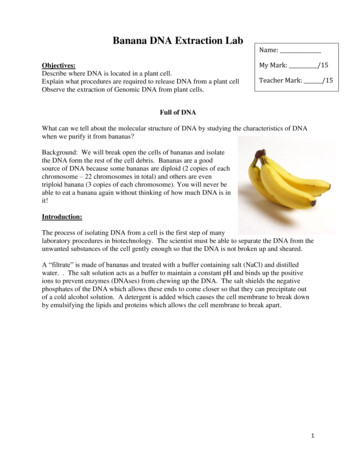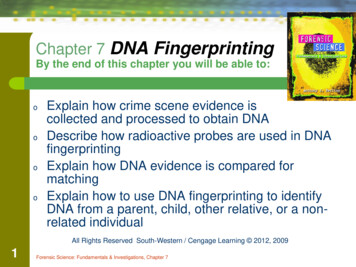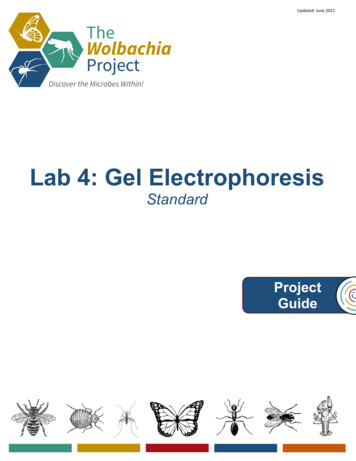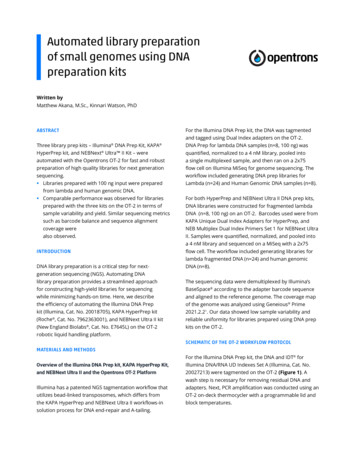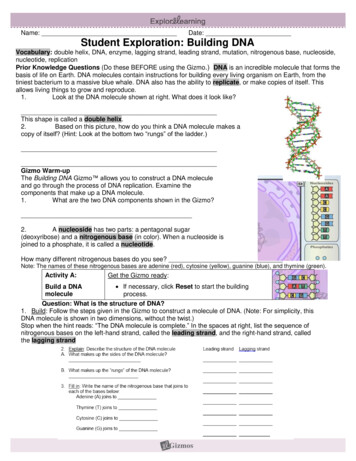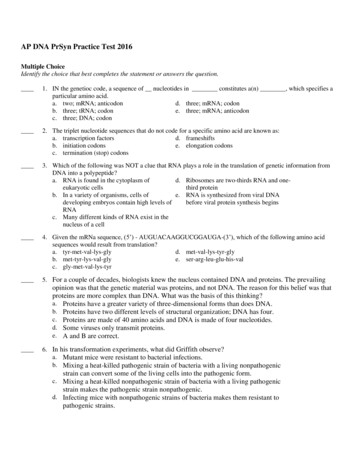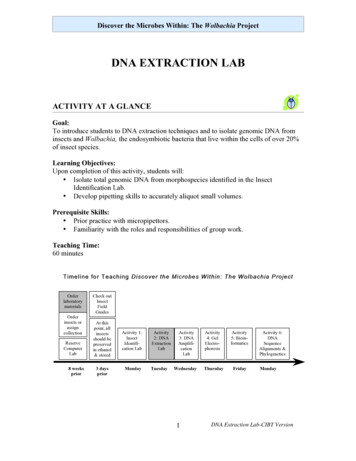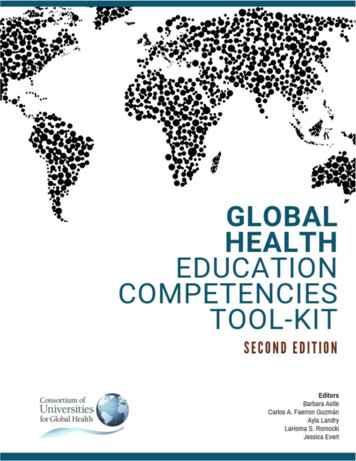
Transcription
OVERVIEW . IAcknowledgements . iiContributing Scholars (2nd edition, 2018) . iiiPeer Reviewers (2nd edition, 2018). iiiContributing Scholars (1st edition, 2017). ivDOMAINS . 15DOMAIN 1. GLOBAL BURDEN OF DISEASE . 2Competency 1a . 3Describe the major causes of morbidity and mortality around the world, and how the risk ofdisease varies with regionsCompetency 1b . 4Describe major public health efforts to reduce disparities in global health (such as SustainableDevelopment Goals (SDGs) and Global Fund to Fight AIDS, TB, and Malaria).Competency 1c . 5Validate the health status of populations using available data (e.g., public health surveillance data,vital statistics, registries, surveys, electronic health records and health plan claims data).DOMAIN 2. GLOBALIZATION OF HEALTH AND HEALTH CARE. 16Competency 2a .17Describe different national models or health systems for provision of healthcare and theirrespective effects on health and healthcare expenditure.Competency 2b .18Describe how global trends in healthcare practice, commerce and culture, multinationalagreements and multinational organizations contribute to the quality and availability of health andhealthcare locally and internationally.Competency 2c .19Describe how travel and trade contribution to the spread of communicable and chronic diseasesCompetency 2d.20Describe general trends and influences in the global availability and movement of health careworkersDOMAIN 3. SOCIAL AND ENVIRONMENTAL DETERMINANTS OF HEALTH . 42Competency 3a .43Describe how cultural context influences perceptions of health and disease.
Competency 3b .44List major social and economic determinants of health and their impacts on the access to andquality of health services and on differences in morbidity and mortality between and withincountriesCompetency 3c .45Describe the relationship between access to and quality of water, sanitation, food and air onindividual and population health.DOMAIN 4. CAPACITY STRENGTHENING . 61Competency 4a .62Collaborate with a host or partner organization to assess the organization’s operational capacityCompetency 4b .63Co-create strategies with the community to strengthen community capabilities and contribute toreduction in health disparities and improvement of community health.Competency 4c .64Integrate community assets and resources to improve the health of individuals and populationsDOMAIN 5. COLLABORATION, PARTNERING AND COMMUNICATION . 82Competency 5a .83Include representatives of diverse constituencies in community partnerships and foster interactivelearning with these partnersCompetency 5b .84Demonstrate diplomacy and build trust with community partners.Competency 5c .85Communicate joint lessons learned to community partners and global constituencies.Competency 5d.86Exhibit interprofessional values and communication skills that demonstrate respect for, andawareness of, the unique cultures, values, roles/responsibilities and expertise represented by otherprofessionals and groups that work in global health.Competency 5e .87Acknowledge one’s limitations in skills, knowledge, and abilitiesCompetency 5f .88Apply leadership practices that support collaborative practice and team effectivenessDOMAIN 6. ETHICS . 109Competency 6a . 111Demonstrate an understanding of and an ability to resolve common ethical issues and challengesthat arise in working within diverse economic, political and cultural contexts as well as workingwith vulnerable populations and in low resource settings to address global health issues.Competency 6b . 112Demonstrate an awareness of local and national codes of ethics relevant to one’s workingenvironment.Competency 6c . 113Apply the fundamental principles of international standards for the protection of human subjectsin diverse cultural settings.DOMAIN 7. PROFESSIONAL PRACTICE. 126Competency 7a . 127Demonstrate integrity, regard and respect for others in all aspects of professional practice.Competency 7b . 128
Articulate barriers to health and healthcare in low-resource settings locally and internationallyCompetency 7c . 129Demonstrate the ability to adapt clinical or discipline-specific skills and practice in a resourceconstrained setting.DOMAIN 8. HEALTH EQUITY AND SOCIAL JUSTICE. 149Competency 8a . 150Apply social justice and human rights principles in addressing global health problems.Competency 8b . 151Implement strategies to engage marginalized and vulnerable populations in making decisions thataffect their health and well-beingCompetency 8c . 152Demonstrate a basic understanding of the relationship between health, human rights, and globalinequities.Competency 8d. 153Describe role of WHO in linking health and human rights, the Universal Declaration of HumanRights, International Ethical Guidelines for Biomedical Research involving Human Subjects.Competency 8e . 154Demonstrate a commitment to social responsibility.Competency 8f . 155Develop understanding and awareness of the health care workforce crisis in the developing world,the factors that contribute to this, and strategies to address this problemDOMAIN 9. PROGRAM MANAGEMENT . 201Competency 9a . 202Plan, implement, and evaluate an evidence-based program.Competency 9b . 202Apply project management techniques throughout program planning, implementation andevaluation.DOMAIN 10. SOCIOCULTURAL AND POLITICAL AWARENESS .211Competency 10a . 212Describe the roles and relationships of the major entities influencing global health anddevelopmentDOMAIN 11. STRATEGIC ANALYSIS . 216Competency 11a . 217Identify how demographic and other major factors can influence patterns of morbidity, mortality,and disability in a defined populationCompetency 11b . 218Conduct a community health needs assessmentCompetency 11c . 219Conduct a situational analysis across a range of cultural, economic, and health contextsCompetency 11d . 220Design context specific-health interventions based upon situation analysis.
The Consortium of Universities for GlobalHealth (CUGH) is a membership organizationfor institutions involved in higher educationand global health – including education,research and practice. The CUGH CompetencySub-committee of the Education Committeehas been instrumental in defining competenciesfor global health education and professionaldevelopment, as well as exploring ongoingconversations and controversies around globalhealth competencies and careers. In 2015, theCompetency Sub-Committee and collaboratorspublished a seminal article in the Annals ofGlobal Health1 defining levels of proficiency,as well as desirable competencies for twolevels – the global citizen level and the basicoperational program oriented level. Whatfollowed was the publication in 2017 of thefirst edition of the Competencies Tool Kit.In the second edition of the CUGH GlobalHealth Education Competencies Tool Kit, it has beenrevised and updated following a similar formatfrom the first edition including: thecompetency, teaching strategies, andaccompanying resources (websites, articles,reports, books, and study questions) thatprovides curricular content to support thecompetencies for those proficiency / traineelevels. What is NEW in this current 2ndedition is the addition of annotatedbibliographies (for many of thecompetencies), which provides a furtherexplanation of the focus of a particularresource, all competencies peer-reviewed andplaced in a “user-friendly” platform. We arehopeful that with this additional information,as users - you will be better able to accessresources for your teaching, research andpractice.Again, it is important to note that itscontributors acknowledge that it continues tobe a “work in progress” much like a “livingdocument” as a “starting point”, rather thana definitive, comprehensive resource. ThisCUGH Competency Sub-committee willcontinue to work on validating the list of thesecompetencies, while further development andexploration will occur at the other levels statedin the 2017 article and within other disciplines.If you have any questions or comments pleasedirect them to the CUGH CompetencySub-Committee Co-Chair, atBarbara.Astle@twu.caJogerst, K., Callender, B., Adams, V., .Wilson, L.L. (2015). Identifyinginterprofessional global health competencies for 21st-century healthprofessionals. Annals of Global Health, 81(2), 239-47.1i
In this second edition of the CUGH Global Health Competencies Toolkit we would like to acknowledge thatthis toolkit is the combined expertise of members of the Competency Sub-Committee and ContributingScholars in global health who are committed to excellence in global health education. We thank ourcolleagues from the 1st edition to this 2nd edition, who gave of their time to ensure that the mostmeaningful information was included to assist our colleagues who teach, research, and practice in thefield of Global Health.The task of the initial creation and updating the tool-kit is an huge undertaking that could only beachieved through the dedication and commitment of both former and current CUGH Competency SubCommittee members, contributing scholars, peer reviewers, graduate students, the editorial team, andsupport from the CUGH Secretariat.We are very excited about this 2nd edition as it has many updates that will be invaluable for our work withour students and colleagues engaged in Global Health.Barbara Astle (Co-Chair, Competency Sub-Committee)Carlos A. Faerron GuzmánAyla LandryLaHoma Smith RomockiJessica Evert (Past Co-chair, Competency Sub-Committee)CUGH Competency Sub-Committee MembersDesign and Digital File Creation:Carolina Bolaños Palmieri2018Citation for Toolkit:Consortium of Universities for Global Health (CUGH) Competency Sub-Committee (2018). CUGHGlobal Health Education Competencies Tool Kit (2nd edition), Washington, DC: Author.ii
Lisa V. AdamsEmmanuelle AllseitsVirginia W. Adams (Retired)Mireille (Mickey) AramatiBarbara AstleKevin CaoDeborah DauduMadhavi DanduKevin DieckhausAndrew DykensJill EdwardsonQuentin EichbaumCarlos A. Faerron GuzmánTifany FrazerJulius HoGabrielle A. JacquetKristen JogerstSydney KamenAnne KellettAyla LandryKajal MehtaNneka MolokwuLaHoma Smith RomockiMichele V. SareNeelam Sekhri FeachemTheresa TownleyJanis TupesisAndres ValencianoJacaranda Van RheenenAnvar VeljiMary T. WhiteDartmouth University, USAUniversity of Illinois at Chicago, USAUniversity of North Carolina, USATufts University, USATrinity Western University, CanadaUniversity of Illinois at Chicago, USAChild Family Health International, USAUniversity of California, San Francisco, USAUniversity of Connecticut, USAUniversity of Illinois at Chicago, USAJohns Hopkins University, USAVanderbilt University, USAUniversity of California, San Francisco Child Family HealthInternational, USAOrganization for Tropical Studies, Costa RicaMedical College of Wisconsin, USAHarvard University, USABoston University, USAHarvard University, USADartmouth University, USAYale University, USAPorches for Progress Nonprofit, NicaraguaHarvard University, USAWashington University in St. Louis, USANorth Carolina Central University, USANurses For Nurses International, USAUniversity of California, San Francisco, USACreighton University, USAUniversity of Wisconsin, USANational Learning Institute, Costa RicaWashington University in St. Louis, USACalifornia Northstate University, USAWright State University, USABarbara AstleNishant A. ChavanJessica EvertCarlos A. Faerron GuzmánAyla LandryCarol LangLaHoma Smith RomockiRaksha SuleTrinity Western University, CanadaLondon School of Hygiene and Tropical Medicine, EnglandUniversity of California; Child Family Health International, USAOrganization for Tropical Studies, Costa RicaPorches for Progress Nonprofit, NicaraguaGeorge Washington University, USANorth Carolina Central University, USAUniversity of Toronto, CanadaJessica Evertiii
Lisa V. AdamsVirginia W. AdamsMireille (Mickey) AramatiBarbara AstleBrian CallenderMadhavi DanduKathleen De LeonKevin DieckhausAndrew DykensJill EdwardsonQuentin EichbaumKathleen, EllisJessica EvertElise FieldsTom HallJulius HoBethany HodgeMichelle HolmGabrielle A. JacquetKristen JogerstAnne KellettDandu MadhaviTamara McKinnonKajal MehtaRahwa NeguseCristina RedkoLaHoma Smith RomockiNeelam Sekhri FeachemLisa SimonTheresa TownleyJanis TupesisLeonel ValdiviaAndres ValencianoJacaranda Van RheenenAnvar VeljiMary T. WhiteLynda WilsonAlicia YamenDartmouth University, USA.University of North Carolina, USATufts University, USATrinity Western University, CanadaUniversity of Chicago, USAUniversity of California, San Francisco, USAUniversity of California San Francisco, USAUniversity of Connecticut, USAUniversity of Illinois at Chicago, USAJohns Hopkins University, USAVanderbilt University, USAMedical University of South Carolina, USAUniversity of California, San Francisco / Child Family HealthInternational, USASeattle Indian Health Board, USASan Francisco, USAHarvard University, USAUniversity of Louisville, USAMayo Clinic, USABoston University, USAHarvard University, USAYale University, USAUniversity of California, USASan Jose State University, USAHarvard University, USAUniversity of California, San Francisco, USAWright State University, USANorth Carolina Central University, USAUniversity of California, San Francisco, USAHarvard University, USACreighton University, USAUniversity of Wisconsin, USAUniversity of Chile, Chile.National Learning Institute, Costa RicaWashington University in St. Louis, USACalifornia Northstate University, USAWright State University, USAUniversity of Alabama Birmingham, USAGeorgetown University, USAiv
Global Burden of DiseaseGlobalization of Health and HealthcareSocial and Environmental Determinants of HealthCapacity StrengtheningCollaboration, Partnering and CommunicationEthicsProfessional PracticeHealth Equity and Social JusticeProgram ManagementSociocultural and Political AwarenessStrategic Analysis
Encompasses basic understandings ofmajor causes of morbidity andmortality and their variations betweenhigh-, middle- and low-incomeregions, and with major public healthefforts to reduce health disparitiesglobally.Global Citizen Level and BasicOperational Program-Oriented Level1aDescribe the major causes ofmorbidity and mortality aroundthe world, and how the risk of diseasevaries with regions1bDescribe major public healthefforts to reduce disparities inglobal health (such as SustainableDevelopment Goals (SDGs) and GlobalFund to Fight AIDS, TB, and Malaria)1cValidate the health status ofpopulations using available data(e.g., public health surveillance data, vitalstatistics, registries, surveys, electronichealth records and health plan claimsdata)
2nd Edition: Ayla Landry (ayla.landry@porchesforprogress.org)1st Edition: Cristina Redko (credko@wright.edu) andMireille (Mickey) Aramati, (Mireille.Aramati@tufts.edu)Share basic background of this topic through articles, videos, and/or interactive lecture in order todefine key terms, morbidity and mortality measurements and factors that contribute/cause morbidityand mortality around the world. The factors that cause morbidity and mortality are more fully reviewedin later competencies (3b,3c, 7b, 8a, 8c 11a). Interactive possibilities for a flipped classroom or teambased learning setting include having students hypothesize their own hypothetical measure for theburden of disease before being introduced to those currently in practice. With a general understandingof morbidity and mortality, students can then explore and discover the extent of which the risk ofdisease varies regionally through online resources and in-class/out-of-class assignments. You could alsocreate a quiz on key terms and/or measures. Some ideas for learning activities include studentpresentations or papers analyzing morbidity and mortality of a particular region with the world or otherregions.Morbidity Mortality Multiple Determinants of Health Disability Adjusted Life Years (DALYs) Quality Adjusted Life Years (QALYs) QALYs vs DALYs – when to use what? Incidence Prevalence3Global Burdenof DiseaseGlobalizationSocial andCollaboration,Capacityof Health andEnvironmentalPartnering andStrengtheningHealthcareDeterminants of HealthCommunicationEthicsProfessional Health Equity andPracticeSocial JusticeProgramManagementSociocultural andPolitical AwarenessStrategicAnalysis
2nd Edition: Mireille (Mickey) Aramati (Mireille.Aramati@tufts.edu) or(maramati@cp,cast.net),and Barbara Astle (Barbara.astle@twu.ca),1st Edition: Cristina Redko (credko@wright.edu) andMireille (Mickey) Aramati (Mireille.Aramati@tufts.edu))Educators may consider starting with the current picture of global health funding and intervention(SDGs, etc.) or take a historical perspective (colonial medicine, etc.) and use past example of changingpriority to allow students to think critically about current global health efforts. Educators may alsoconsider including some local efforts to reduce health disparity in their own communities. If teachingCompetency 1A prior to 1B, consider bridging the two competencies by discussing the concept ofneeds assessment and how prioritization may change the way global efforts are mediated.For educators in the health professions, it should be noted that MedEd Portal has a number oflectures/exercises pertaining to this competency that are freely available for download and adaptationtoo.4Global Burdenof DiseaseGlobalizationSocial andCollaboration,Capacityof Health andEnvironmentalPartnering andStrengtheningHealthcareDeterminants of HealthCommunicationEthicsProfessional Health Equity andPracticeSocial JusticeProgramManagementSociocultural andPolitical AwarenessStrategicAnalysis
2nd Edition: Anvar Velji (anvarvelji@gmail.com)Neelam Sekhri Feachem (Neelam.Feachem@ucsf.edu)1st Edition: Anvar Velji (anvarvelji@gmail.com), Lynda Wilson (lyndawilson@uab.edu)Neelam Sekhri Feachem (Neelam.Feachem@ucsf.edu)Validating the health status of populations has taken a historical leap in the last several years due tomore accurate data gathering at macro and micro levels and with the publications of the widelydisseminated Global Burden of Disease Studies.Initial background on this topic will require a combination of landmark articles, a textbook assigned asrequired reading, with supplemental assignments of videos, blogs, and exploration of websites, lectureor flipped classrooms with voice over power points. It will also include individual and team- basedlearning to encourage active learning and better retention.5Global Burdenof DiseaseGlobalizationSocial andCollaboration,Capacityof Health andEnvironmentalPartnering andStrengtheningHealthcareDeterminants of HealthCommunicationEthicsProfessional Health Equity andPracticeSocial JusticeProgramManagementSociocultural andPolitical AwarenessStrategicAnalysis
Gap Minder. (n.d.). Retrieved from https://www.gapminder.org/tools/This interactive resource allows users to change the axis of a graph, map or table in order tocustomize how you compare and contrast health indicator measures, populations, andcountries.Global Health Learning. (2011). Mortality Surveillance Methods Strategies. Retrieved rtality-surveillance-methods-strategiesThis course will provide participants with a basic understanding of the importance andusefulness of mortality data and introduce a range of approaches to collecting such data. Theadvantages and limitations of the various methods will also be discussed.” You must set-up afree account in order to access/register for the course.Institute for Health Metrics and Evaluation. (2016). Data visualizations. Retrieved zationsMorbidity and mortality data is depicted in several different visuals that enable information tobe understood without looking at the raw numbers/graphs/statistics.Johns Hopkins Bloomberg School of Public Health OpenCourseWare, && Mosley, H. (2006).Mortality and morbidity: Determinants and measurements.[PDF document]. Retrievedfrom /Lecture6.pdfThese open access lecture slides describe the sources of data and the common measurementsfor morbidity and mortality.Massachusetts Institute of Technology OpenCourseWare, & Jones, D. (2010).The burden ofdisease.[PDF document]Retrieved from g-2010/readings-and-lectures/MITHST 934JS10 02 4 Burden.pdfThese lecture slides describe health indicator data including morbidity and mortality measures,visualizations of health disparities and discusses contributing factors.World Health Organization. (n.d.). Global burden of disease. Retrieved fromhttp://www.who.int/topics/global burden of disease/en/This website gives a basic definition and overview of the current global burden of disease withlinks to more in-depth resources.World Health Organization (n.d.). Global Health Observatory Data. NCDs mortality and morbidity.Retrieved from http://www.who.int/gho/ncd/mortality morbidity/en/6Global Burdenof DiseaseGlobalizationSocial andCollaboration,Capacityof Health andEnvironmentalPartnering andStrengtheningHealthcareDeterminants of HealthCommunicationEthicsProfessional Health Equity andPracticeSocial JusticeProgramManagementSociocultural andPolitical AwarenessStrategicAnalysis
This website gives a basic overview of current global morbidity and mortality caused bynoncommunicable disease with links to more in-depth resources.World Health Organization. (n.d.). Mortality. Retrieved fromhttp://www.who.int/topics/mortality/en/This website gives a basic definition and overview of current global causes of death with linksto more in-depth resources.Murray, C. J. L., Phil, D., & Lopez, A. D. (2013). Measuring the global burden of disease. New EnglandJournal of Medicine, 369(5), 448-457. Retrieved 0/GlobBurdDis NEJM 2013.pdfThis article reviews the measurement, key findings from the 2010 global burden of diseasestudy and describes changes in global morbidity and mortality since 1990. It addition the articlediscusses application and use for the data including benchmarking for futureThe Lancet. (n.d.). Global burden of disease. Retrieved from http://www.thelancet.com/gbdThis website holds a number of articles and visualizations that have emerged from the GlobalBurden of Disease Study which reviews and analyzes major causes of morbidity and mortalityfrom 1990-2016. Various articles are available looking at the data by regions, demographicfactors, and causes.World Health Organization. (2011). Burden: mortality, morbidity and risk factors. In Global statusreport on noncommunicable disease (pp.9-31). Retrieved fromhttp://www.who.int/nmh/publications/ncd report2010/en/The first chapter of this report describes the burden of disease and trends ofnoncommunicable diseases and the risk factors. It also provides estimates on the number, ratesand causes of global deaths from NCDs and the prevalence of the most important related riskfactors.Neumann, P.J., Anderson, J.E., Panzer, A.D., Pope, E.F.
Gabrielle A. Jacquet Boston University, USA Kristen Jogerst Harvard University, USA Sydney Kamen Dartmouth University, USA Anne Kellett Yale University, USA Ayla Landry Porches for Progress Nonprofit, Nicaragua Kajal Mehta Harvard University, USA Nneka Molokwu Washington University in St. Louis, USA
